Comprehensive Business Strategy Report: Tesco PLC Analysis
VerifiedAdded on 2023/06/10
|17
|5624
|114
Report
AI Summary
This business strategy report provides a comprehensive analysis of Tesco PLC, a British international groceries and general merchandise retailer. It examines Tesco's strategic context, including its vision, mission, and objectives, and analyzes the macro environment using PESTLE and stakeholder analysis. The report delves into Tesco's internal environment and capabilities through SWOT analysis and value chain analysis, assessing its strengths, weaknesses, opportunities, and threats. Analytical tools like Porter’s Five Forces and the Ansoff matrix are employed to evaluate Tesco's competitive position and potential growth strategies. The report concludes by discussing strategic choices and directions, focusing on generic strategies and strategies for competitive advantage. The analysis aims to provide insights into Tesco's strategic management and its approach to maintaining a competitive edge in the market.
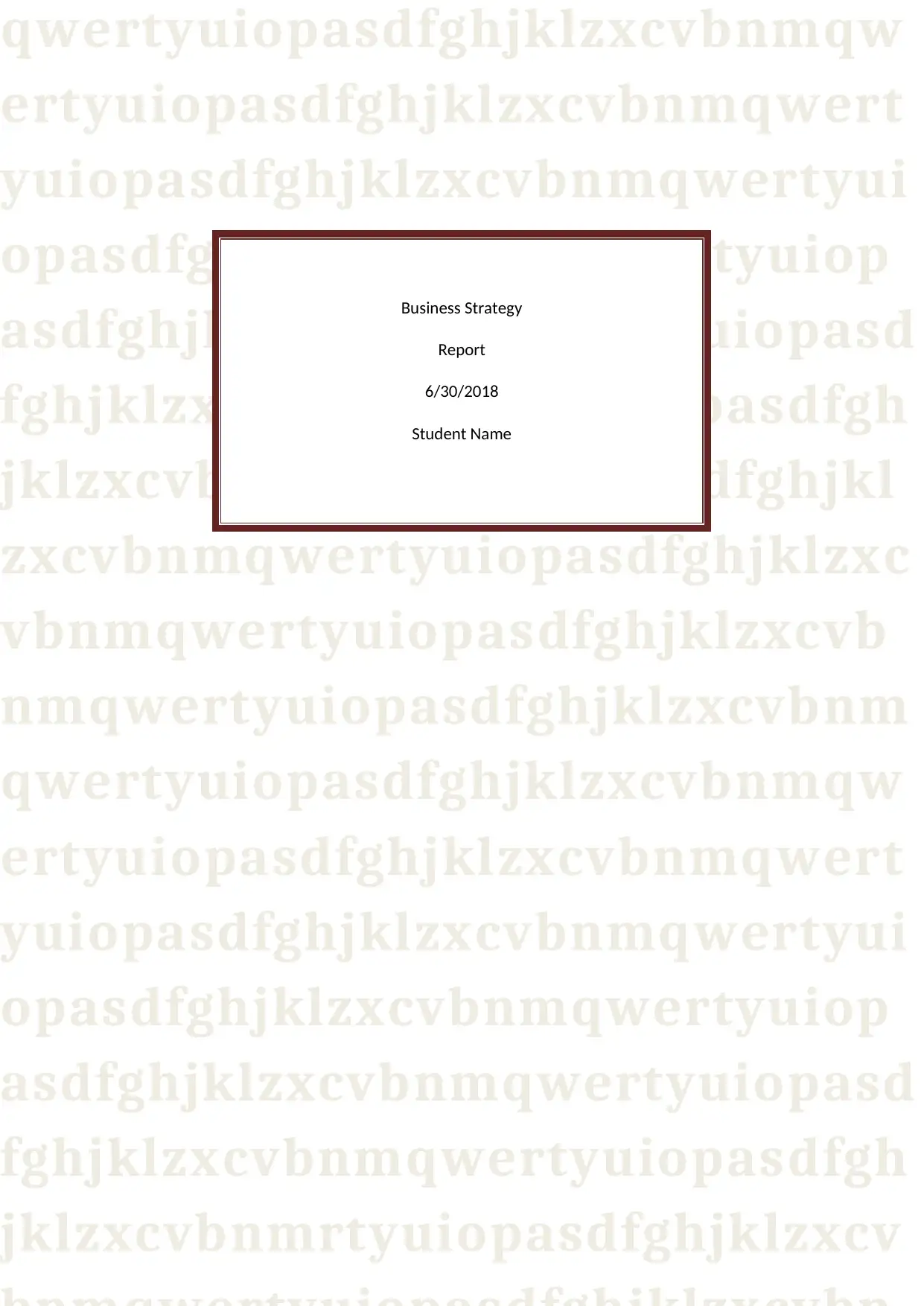
qwertyuiopasdfghjklzxcvbnmqw
ertyuiopasdfghjklzxcvbnmqwert
yuiopasdfghjklzxcvbnmqwertyui
opasdfghjklzxcvbnmqwertyuiop
asdfghjklzxcvbnmqwertyuiopasd
fghjklzxcvbnmqwertyuiopasdfgh
jklzxcvbnmqwertyuiopasdfghjkl
zxcvbnmqwertyuiopasdfghjklzxc
vbnmqwertyuiopasdfghjklzxcvb
nmqwertyuiopasdfghjklzxcvbnm
qwertyuiopasdfghjklzxcvbnmqw
ertyuiopasdfghjklzxcvbnmqwert
yuiopasdfghjklzxcvbnmqwertyui
opasdfghjklzxcvbnmqwertyuiop
asdfghjklzxcvbnmqwertyuiopasd
fghjklzxcvbnmqwertyuiopasdfgh
jklzxcvbnmrtyuiopasdfghjklzxcv
Business Strategy
Report
6/30/2018
Student Name
ertyuiopasdfghjklzxcvbnmqwert
yuiopasdfghjklzxcvbnmqwertyui
opasdfghjklzxcvbnmqwertyuiop
asdfghjklzxcvbnmqwertyuiopasd
fghjklzxcvbnmqwertyuiopasdfgh
jklzxcvbnmqwertyuiopasdfghjkl
zxcvbnmqwertyuiopasdfghjklzxc
vbnmqwertyuiopasdfghjklzxcvb
nmqwertyuiopasdfghjklzxcvbnm
qwertyuiopasdfghjklzxcvbnmqw
ertyuiopasdfghjklzxcvbnmqwert
yuiopasdfghjklzxcvbnmqwertyui
opasdfghjklzxcvbnmqwertyuiop
asdfghjklzxcvbnmqwertyuiopasd
fghjklzxcvbnmqwertyuiopasdfgh
jklzxcvbnmrtyuiopasdfghjklzxcv
Business Strategy
Report
6/30/2018
Student Name
Paraphrase This Document
Need a fresh take? Get an instant paraphrase of this document with our AI Paraphraser
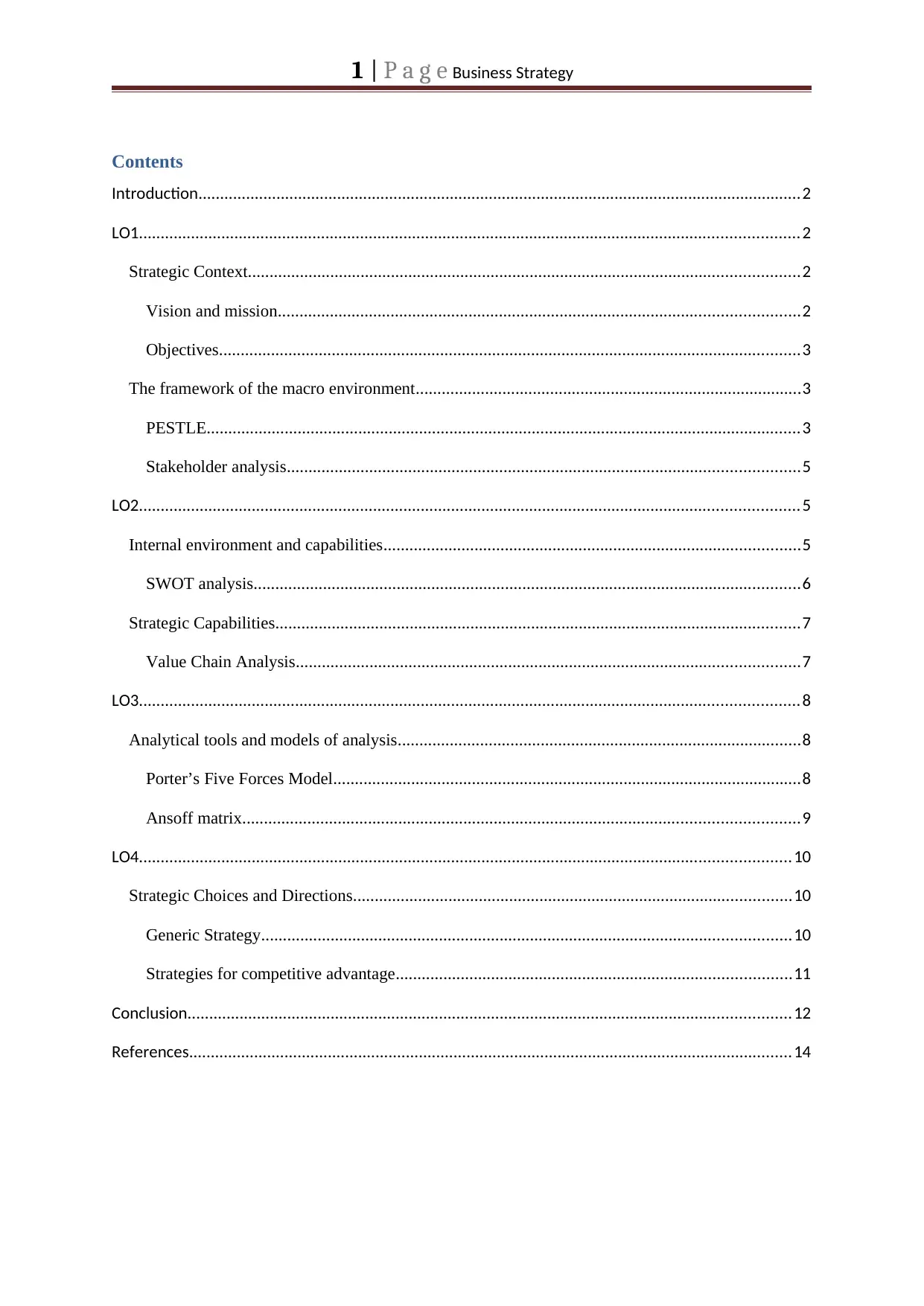
1 | P a g e Business Strategy
Contents
Introduction...........................................................................................................................................2
LO1........................................................................................................................................................2
Strategic Context...............................................................................................................................2
Vision and mission........................................................................................................................2
Objectives......................................................................................................................................3
The framework of the macro environment.........................................................................................3
PESTLE.........................................................................................................................................3
Stakeholder analysis......................................................................................................................5
LO2........................................................................................................................................................5
Internal environment and capabilities................................................................................................5
SWOT analysis..............................................................................................................................6
Strategic Capabilities.........................................................................................................................7
Value Chain Analysis....................................................................................................................7
LO3........................................................................................................................................................8
Analytical tools and models of analysis.............................................................................................8
Porter’s Five Forces Model............................................................................................................8
Ansoff matrix................................................................................................................................9
LO4......................................................................................................................................................10
Strategic Choices and Directions.....................................................................................................10
Generic Strategy..........................................................................................................................10
Strategies for competitive advantage...........................................................................................11
Conclusion...........................................................................................................................................12
References...........................................................................................................................................14
Contents
Introduction...........................................................................................................................................2
LO1........................................................................................................................................................2
Strategic Context...............................................................................................................................2
Vision and mission........................................................................................................................2
Objectives......................................................................................................................................3
The framework of the macro environment.........................................................................................3
PESTLE.........................................................................................................................................3
Stakeholder analysis......................................................................................................................5
LO2........................................................................................................................................................5
Internal environment and capabilities................................................................................................5
SWOT analysis..............................................................................................................................6
Strategic Capabilities.........................................................................................................................7
Value Chain Analysis....................................................................................................................7
LO3........................................................................................................................................................8
Analytical tools and models of analysis.............................................................................................8
Porter’s Five Forces Model............................................................................................................8
Ansoff matrix................................................................................................................................9
LO4......................................................................................................................................................10
Strategic Choices and Directions.....................................................................................................10
Generic Strategy..........................................................................................................................10
Strategies for competitive advantage...........................................................................................11
Conclusion...........................................................................................................................................12
References...........................................................................................................................................14
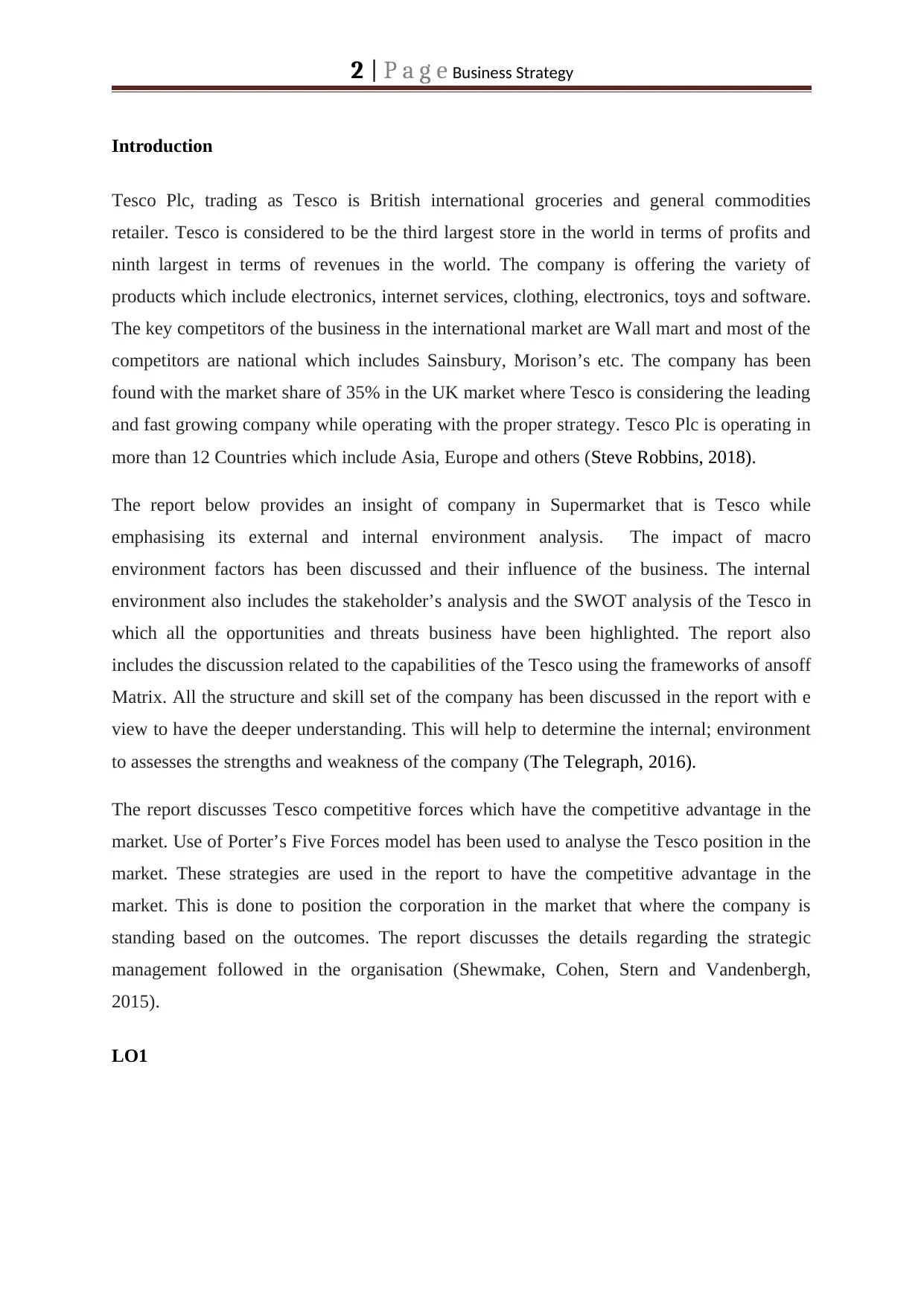
2 | P a g e Business Strategy
Introduction
Tesco Plc, trading as Tesco is British international groceries and general commodities
retailer. Tesco is considered to be the third largest store in the world in terms of profits and
ninth largest in terms of revenues in the world. The company is offering the variety of
products which include electronics, internet services, clothing, electronics, toys and software.
The key competitors of the business in the international market are Wall mart and most of the
competitors are national which includes Sainsbury, Morison’s etc. The company has been
found with the market share of 35% in the UK market where Tesco is considering the leading
and fast growing company while operating with the proper strategy. Tesco Plc is operating in
more than 12 Countries which include Asia, Europe and others (Steve Robbins, 2018).
The report below provides an insight of company in Supermarket that is Tesco while
emphasising its external and internal environment analysis. The impact of macro
environment factors has been discussed and their influence of the business. The internal
environment also includes the stakeholder’s analysis and the SWOT analysis of the Tesco in
which all the opportunities and threats business have been highlighted. The report also
includes the discussion related to the capabilities of the Tesco using the frameworks of ansoff
Matrix. All the structure and skill set of the company has been discussed in the report with e
view to have the deeper understanding. This will help to determine the internal; environment
to assesses the strengths and weakness of the company (The Telegraph, 2016).
The report discusses Tesco competitive forces which have the competitive advantage in the
market. Use of Porter’s Five Forces model has been used to analyse the Tesco position in the
market. These strategies are used in the report to have the competitive advantage in the
market. This is done to position the corporation in the market that where the company is
standing based on the outcomes. The report discusses the details regarding the strategic
management followed in the organisation (Shewmake, Cohen, Stern and Vandenbergh,
2015).
LO1
Introduction
Tesco Plc, trading as Tesco is British international groceries and general commodities
retailer. Tesco is considered to be the third largest store in the world in terms of profits and
ninth largest in terms of revenues in the world. The company is offering the variety of
products which include electronics, internet services, clothing, electronics, toys and software.
The key competitors of the business in the international market are Wall mart and most of the
competitors are national which includes Sainsbury, Morison’s etc. The company has been
found with the market share of 35% in the UK market where Tesco is considering the leading
and fast growing company while operating with the proper strategy. Tesco Plc is operating in
more than 12 Countries which include Asia, Europe and others (Steve Robbins, 2018).
The report below provides an insight of company in Supermarket that is Tesco while
emphasising its external and internal environment analysis. The impact of macro
environment factors has been discussed and their influence of the business. The internal
environment also includes the stakeholder’s analysis and the SWOT analysis of the Tesco in
which all the opportunities and threats business have been highlighted. The report also
includes the discussion related to the capabilities of the Tesco using the frameworks of ansoff
Matrix. All the structure and skill set of the company has been discussed in the report with e
view to have the deeper understanding. This will help to determine the internal; environment
to assesses the strengths and weakness of the company (The Telegraph, 2016).
The report discusses Tesco competitive forces which have the competitive advantage in the
market. Use of Porter’s Five Forces model has been used to analyse the Tesco position in the
market. These strategies are used in the report to have the competitive advantage in the
market. This is done to position the corporation in the market that where the company is
standing based on the outcomes. The report discusses the details regarding the strategic
management followed in the organisation (Shewmake, Cohen, Stern and Vandenbergh,
2015).
LO1
⊘ This is a preview!⊘
Do you want full access?
Subscribe today to unlock all pages.

Trusted by 1+ million students worldwide
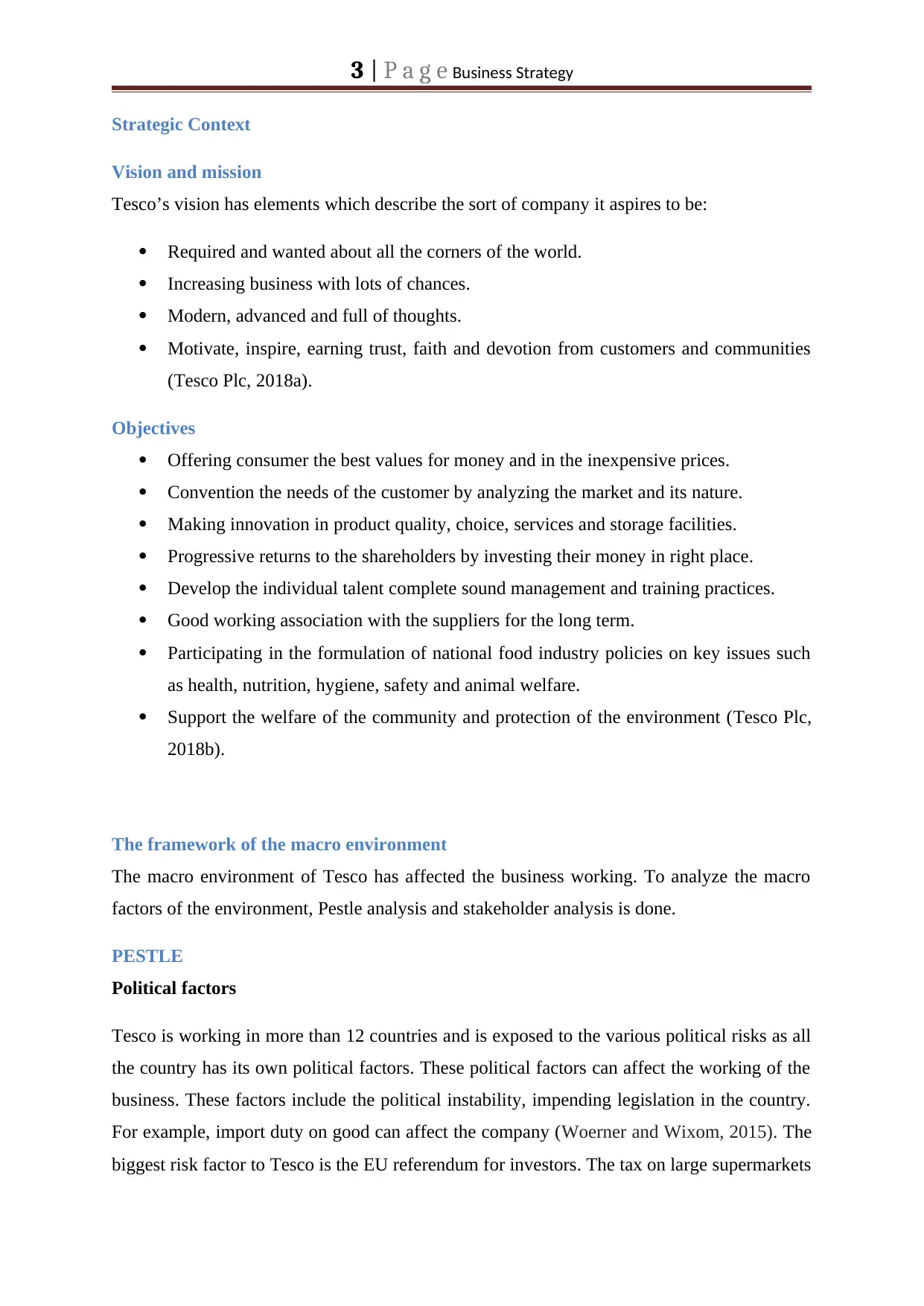
3 | P a g e Business Strategy
Strategic Context
Vision and mission
Tesco’s vision has elements which describe the sort of company it aspires to be:
Required and wanted about all the corners of the world.
Increasing business with lots of chances.
Modern, advanced and full of thoughts.
Motivate, inspire, earning trust, faith and devotion from customers and communities
(Tesco Plc, 2018a).
Objectives
Offering consumer the best values for money and in the inexpensive prices.
Convention the needs of the customer by analyzing the market and its nature.
Making innovation in product quality, choice, services and storage facilities.
Progressive returns to the shareholders by investing their money in right place.
Develop the individual talent complete sound management and training practices.
Good working association with the suppliers for the long term.
Participating in the formulation of national food industry policies on key issues such
as health, nutrition, hygiene, safety and animal welfare.
Support the welfare of the community and protection of the environment (Tesco Plc,
2018b).
The framework of the macro environment
The macro environment of Tesco has affected the business working. To analyze the macro
factors of the environment, Pestle analysis and stakeholder analysis is done.
PESTLE
Political factors
Tesco is working in more than 12 countries and is exposed to the various political risks as all
the country has its own political factors. These political factors can affect the working of the
business. These factors include the political instability, impending legislation in the country.
For example, import duty on good can affect the company (Woerner and Wixom, 2015). The
biggest risk factor to Tesco is the EU referendum for investors. The tax on large supermarkets
Strategic Context
Vision and mission
Tesco’s vision has elements which describe the sort of company it aspires to be:
Required and wanted about all the corners of the world.
Increasing business with lots of chances.
Modern, advanced and full of thoughts.
Motivate, inspire, earning trust, faith and devotion from customers and communities
(Tesco Plc, 2018a).
Objectives
Offering consumer the best values for money and in the inexpensive prices.
Convention the needs of the customer by analyzing the market and its nature.
Making innovation in product quality, choice, services and storage facilities.
Progressive returns to the shareholders by investing their money in right place.
Develop the individual talent complete sound management and training practices.
Good working association with the suppliers for the long term.
Participating in the formulation of national food industry policies on key issues such
as health, nutrition, hygiene, safety and animal welfare.
Support the welfare of the community and protection of the environment (Tesco Plc,
2018b).
The framework of the macro environment
The macro environment of Tesco has affected the business working. To analyze the macro
factors of the environment, Pestle analysis and stakeholder analysis is done.
PESTLE
Political factors
Tesco is working in more than 12 countries and is exposed to the various political risks as all
the country has its own political factors. These political factors can affect the working of the
business. These factors include the political instability, impending legislation in the country.
For example, import duty on good can affect the company (Woerner and Wixom, 2015). The
biggest risk factor to Tesco is the EU referendum for investors. The tax on large supermarkets
Paraphrase This Document
Need a fresh take? Get an instant paraphrase of this document with our AI Paraphraser
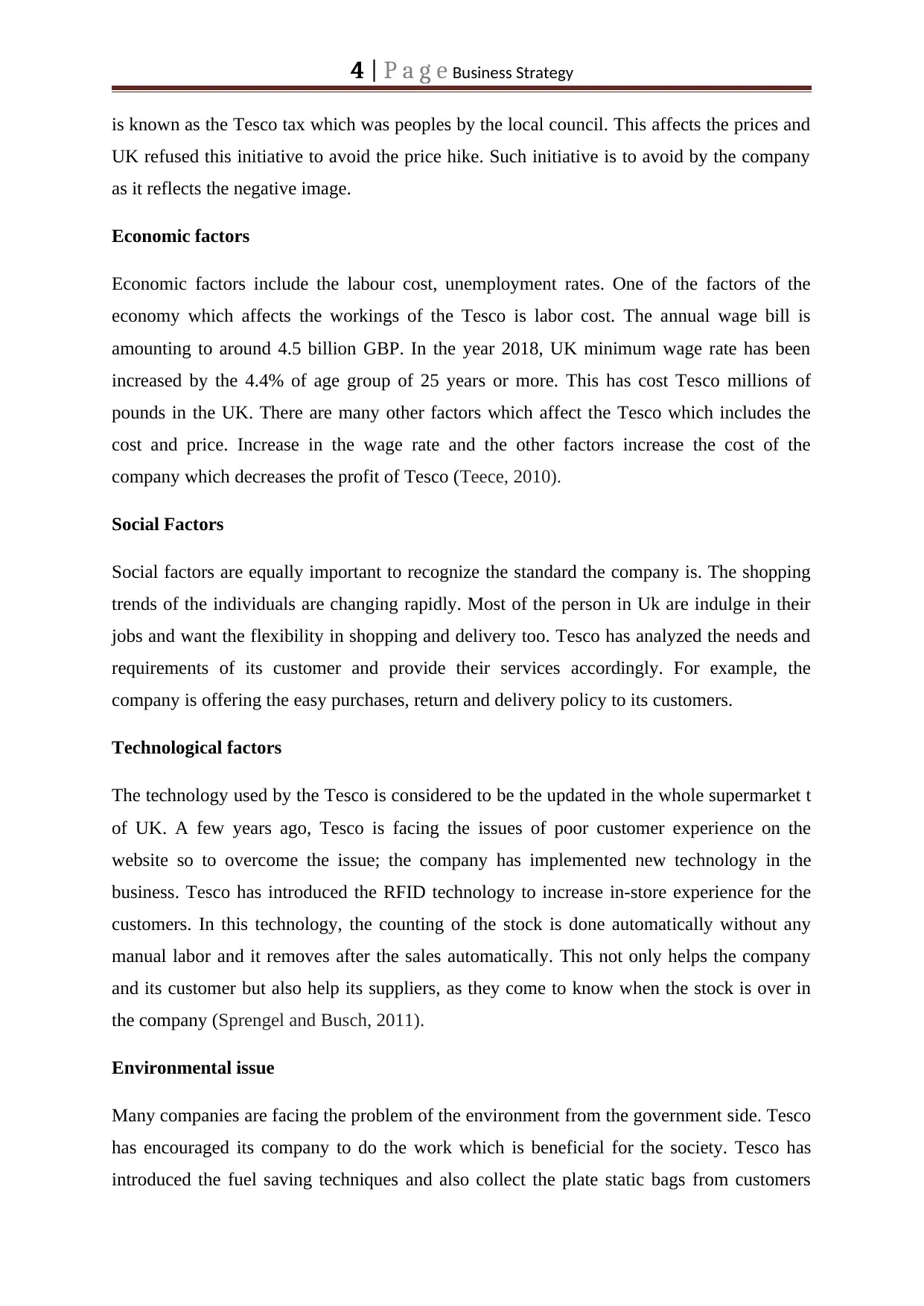
4 | P a g e Business Strategy
is known as the Tesco tax which was peoples by the local council. This affects the prices and
UK refused this initiative to avoid the price hike. Such initiative is to avoid by the company
as it reflects the negative image.
Economic factors
Economic factors include the labour cost, unemployment rates. One of the factors of the
economy which affects the workings of the Tesco is labor cost. The annual wage bill is
amounting to around 4.5 billion GBP. In the year 2018, UK minimum wage rate has been
increased by the 4.4% of age group of 25 years or more. This has cost Tesco millions of
pounds in the UK. There are many other factors which affect the Tesco which includes the
cost and price. Increase in the wage rate and the other factors increase the cost of the
company which decreases the profit of Tesco (Teece, 2010).
Social Factors
Social factors are equally important to recognize the standard the company is. The shopping
trends of the individuals are changing rapidly. Most of the person in Uk are indulge in their
jobs and want the flexibility in shopping and delivery too. Tesco has analyzed the needs and
requirements of its customer and provide their services accordingly. For example, the
company is offering the easy purchases, return and delivery policy to its customers.
Technological factors
The technology used by the Tesco is considered to be the updated in the whole supermarket t
of UK. A few years ago, Tesco is facing the issues of poor customer experience on the
website so to overcome the issue; the company has implemented new technology in the
business. Tesco has introduced the RFID technology to increase in-store experience for the
customers. In this technology, the counting of the stock is done automatically without any
manual labor and it removes after the sales automatically. This not only helps the company
and its customer but also help its suppliers, as they come to know when the stock is over in
the company (Sprengel and Busch, 2011).
Environmental issue
Many companies are facing the problem of the environment from the government side. Tesco
has encouraged its company to do the work which is beneficial for the society. Tesco has
introduced the fuel saving techniques and also collect the plate static bags from customers
is known as the Tesco tax which was peoples by the local council. This affects the prices and
UK refused this initiative to avoid the price hike. Such initiative is to avoid by the company
as it reflects the negative image.
Economic factors
Economic factors include the labour cost, unemployment rates. One of the factors of the
economy which affects the workings of the Tesco is labor cost. The annual wage bill is
amounting to around 4.5 billion GBP. In the year 2018, UK minimum wage rate has been
increased by the 4.4% of age group of 25 years or more. This has cost Tesco millions of
pounds in the UK. There are many other factors which affect the Tesco which includes the
cost and price. Increase in the wage rate and the other factors increase the cost of the
company which decreases the profit of Tesco (Teece, 2010).
Social Factors
Social factors are equally important to recognize the standard the company is. The shopping
trends of the individuals are changing rapidly. Most of the person in Uk are indulge in their
jobs and want the flexibility in shopping and delivery too. Tesco has analyzed the needs and
requirements of its customer and provide their services accordingly. For example, the
company is offering the easy purchases, return and delivery policy to its customers.
Technological factors
The technology used by the Tesco is considered to be the updated in the whole supermarket t
of UK. A few years ago, Tesco is facing the issues of poor customer experience on the
website so to overcome the issue; the company has implemented new technology in the
business. Tesco has introduced the RFID technology to increase in-store experience for the
customers. In this technology, the counting of the stock is done automatically without any
manual labor and it removes after the sales automatically. This not only helps the company
and its customer but also help its suppliers, as they come to know when the stock is over in
the company (Sprengel and Busch, 2011).
Environmental issue
Many companies are facing the problem of the environment from the government side. Tesco
has encouraged its company to do the work which is beneficial for the society. Tesco has
introduced the fuel saving techniques and also collect the plate static bags from customers
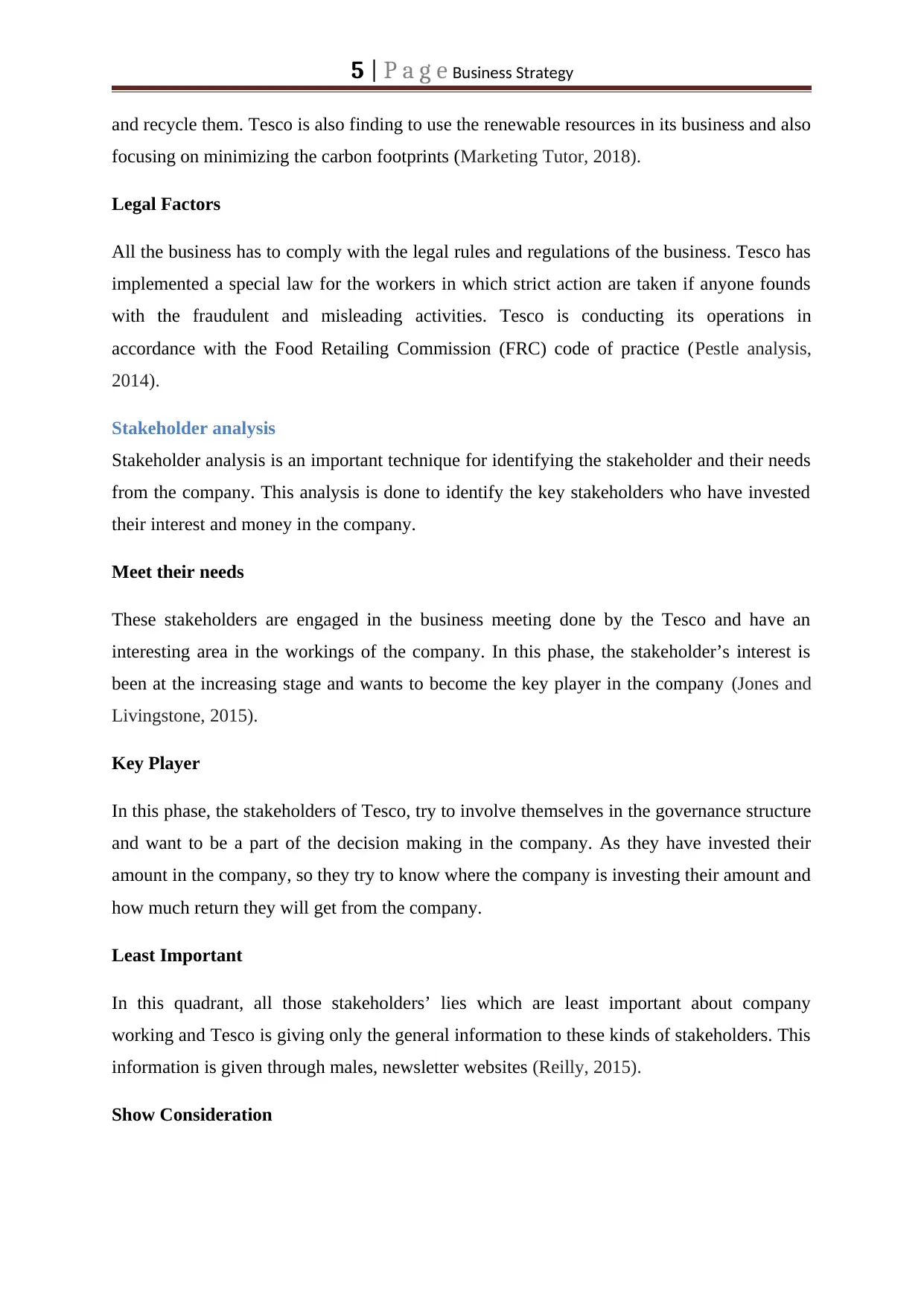
5 | P a g e Business Strategy
and recycle them. Tesco is also finding to use the renewable resources in its business and also
focusing on minimizing the carbon footprints (Marketing Tutor, 2018).
Legal Factors
All the business has to comply with the legal rules and regulations of the business. Tesco has
implemented a special law for the workers in which strict action are taken if anyone founds
with the fraudulent and misleading activities. Tesco is conducting its operations in
accordance with the Food Retailing Commission (FRC) code of practice (Pestle analysis,
2014).
Stakeholder analysis
Stakeholder analysis is an important technique for identifying the stakeholder and their needs
from the company. This analysis is done to identify the key stakeholders who have invested
their interest and money in the company.
Meet their needs
These stakeholders are engaged in the business meeting done by the Tesco and have an
interesting area in the workings of the company. In this phase, the stakeholder’s interest is
been at the increasing stage and wants to become the key player in the company (Jones and
Livingstone, 2015).
Key Player
In this phase, the stakeholders of Tesco, try to involve themselves in the governance structure
and want to be a part of the decision making in the company. As they have invested their
amount in the company, so they try to know where the company is investing their amount and
how much return they will get from the company.
Least Important
In this quadrant, all those stakeholders’ lies which are least important about company
working and Tesco is giving only the general information to these kinds of stakeholders. This
information is given through males, newsletter websites (Reilly, 2015).
Show Consideration
and recycle them. Tesco is also finding to use the renewable resources in its business and also
focusing on minimizing the carbon footprints (Marketing Tutor, 2018).
Legal Factors
All the business has to comply with the legal rules and regulations of the business. Tesco has
implemented a special law for the workers in which strict action are taken if anyone founds
with the fraudulent and misleading activities. Tesco is conducting its operations in
accordance with the Food Retailing Commission (FRC) code of practice (Pestle analysis,
2014).
Stakeholder analysis
Stakeholder analysis is an important technique for identifying the stakeholder and their needs
from the company. This analysis is done to identify the key stakeholders who have invested
their interest and money in the company.
Meet their needs
These stakeholders are engaged in the business meeting done by the Tesco and have an
interesting area in the workings of the company. In this phase, the stakeholder’s interest is
been at the increasing stage and wants to become the key player in the company (Jones and
Livingstone, 2015).
Key Player
In this phase, the stakeholders of Tesco, try to involve themselves in the governance structure
and want to be a part of the decision making in the company. As they have invested their
amount in the company, so they try to know where the company is investing their amount and
how much return they will get from the company.
Least Important
In this quadrant, all those stakeholders’ lies which are least important about company
working and Tesco is giving only the general information to these kinds of stakeholders. This
information is given through males, newsletter websites (Reilly, 2015).
Show Consideration
⊘ This is a preview!⊘
Do you want full access?
Subscribe today to unlock all pages.

Trusted by 1+ million students worldwide
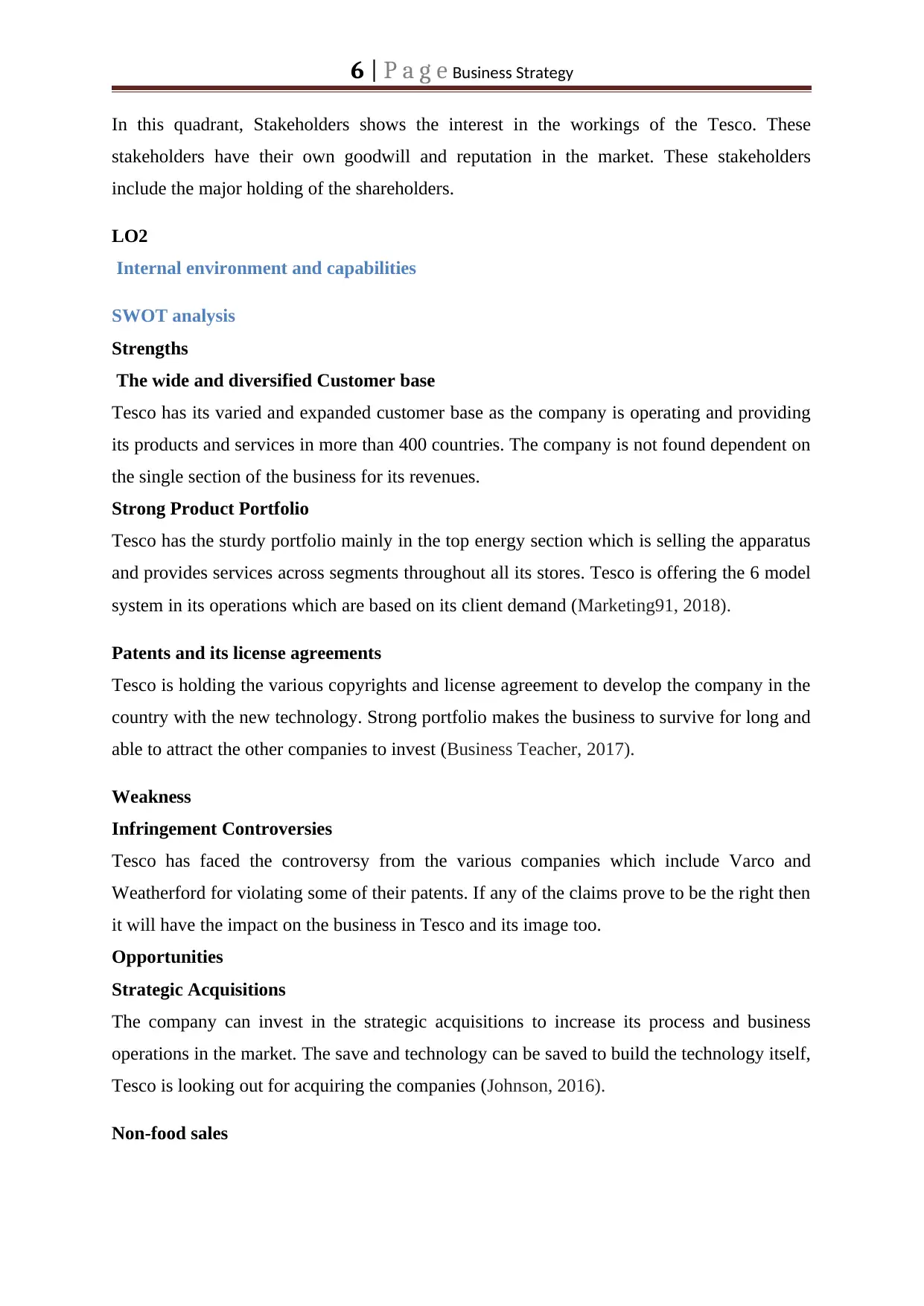
6 | P a g e Business Strategy
In this quadrant, Stakeholders shows the interest in the workings of the Tesco. These
stakeholders have their own goodwill and reputation in the market. These stakeholders
include the major holding of the shareholders.
LO2
Internal environment and capabilities
SWOT analysis
Strengths
The wide and diversified Customer base
Tesco has its varied and expanded customer base as the company is operating and providing
its products and services in more than 400 countries. The company is not found dependent on
the single section of the business for its revenues.
Strong Product Portfolio
Tesco has the sturdy portfolio mainly in the top energy section which is selling the apparatus
and provides services across segments throughout all its stores. Tesco is offering the 6 model
system in its operations which are based on its client demand (Marketing91, 2018).
Patents and its license agreements
Tesco is holding the various copyrights and license agreement to develop the company in the
country with the new technology. Strong portfolio makes the business to survive for long and
able to attract the other companies to invest (Business Teacher, 2017).
Weakness
Infringement Controversies
Tesco has faced the controversy from the various companies which include Varco and
Weatherford for violating some of their patents. If any of the claims prove to be the right then
it will have the impact on the business in Tesco and its image too.
Opportunities
Strategic Acquisitions
The company can invest in the strategic acquisitions to increase its process and business
operations in the market. The save and technology can be saved to build the technology itself,
Tesco is looking out for acquiring the companies (Johnson, 2016).
Non-food sales
In this quadrant, Stakeholders shows the interest in the workings of the Tesco. These
stakeholders have their own goodwill and reputation in the market. These stakeholders
include the major holding of the shareholders.
LO2
Internal environment and capabilities
SWOT analysis
Strengths
The wide and diversified Customer base
Tesco has its varied and expanded customer base as the company is operating and providing
its products and services in more than 400 countries. The company is not found dependent on
the single section of the business for its revenues.
Strong Product Portfolio
Tesco has the sturdy portfolio mainly in the top energy section which is selling the apparatus
and provides services across segments throughout all its stores. Tesco is offering the 6 model
system in its operations which are based on its client demand (Marketing91, 2018).
Patents and its license agreements
Tesco is holding the various copyrights and license agreement to develop the company in the
country with the new technology. Strong portfolio makes the business to survive for long and
able to attract the other companies to invest (Business Teacher, 2017).
Weakness
Infringement Controversies
Tesco has faced the controversy from the various companies which include Varco and
Weatherford for violating some of their patents. If any of the claims prove to be the right then
it will have the impact on the business in Tesco and its image too.
Opportunities
Strategic Acquisitions
The company can invest in the strategic acquisitions to increase its process and business
operations in the market. The save and technology can be saved to build the technology itself,
Tesco is looking out for acquiring the companies (Johnson, 2016).
Non-food sales
Paraphrase This Document
Need a fresh take? Get an instant paraphrase of this document with our AI Paraphraser
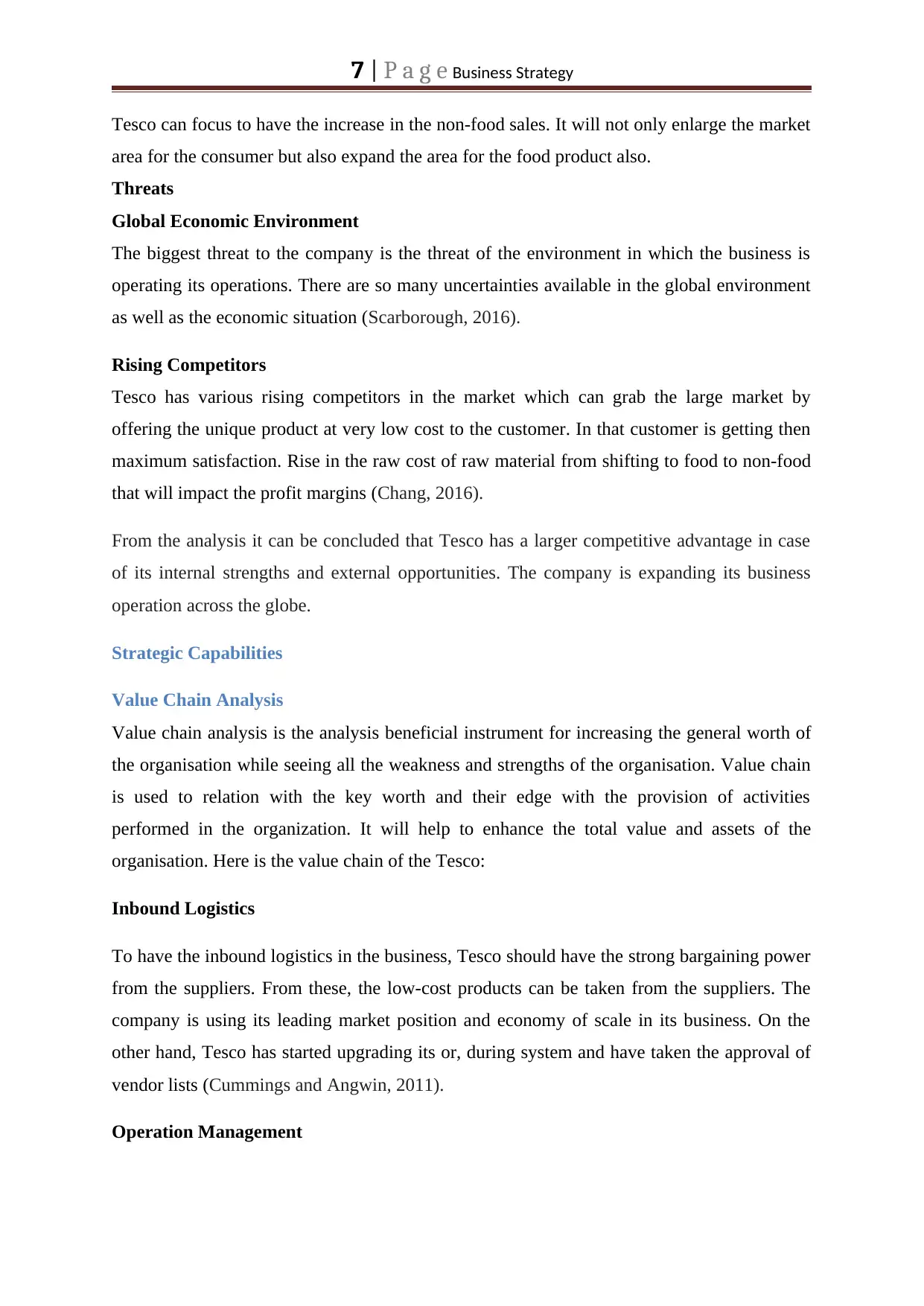
7 | P a g e Business Strategy
Tesco can focus to have the increase in the non-food sales. It will not only enlarge the market
area for the consumer but also expand the area for the food product also.
Threats
Global Economic Environment
The biggest threat to the company is the threat of the environment in which the business is
operating its operations. There are so many uncertainties available in the global environment
as well as the economic situation (Scarborough, 2016).
Rising Competitors
Tesco has various rising competitors in the market which can grab the large market by
offering the unique product at very low cost to the customer. In that customer is getting then
maximum satisfaction. Rise in the raw cost of raw material from shifting to food to non-food
that will impact the profit margins (Chang, 2016).
From the analysis it can be concluded that Tesco has a larger competitive advantage in case
of its internal strengths and external opportunities. The company is expanding its business
operation across the globe.
Strategic Capabilities
Value Chain Analysis
Value chain analysis is the analysis beneficial instrument for increasing the general worth of
the organisation while seeing all the weakness and strengths of the organisation. Value chain
is used to relation with the key worth and their edge with the provision of activities
performed in the organization. It will help to enhance the total value and assets of the
organisation. Here is the value chain of the Tesco:
Inbound Logistics
To have the inbound logistics in the business, Tesco should have the strong bargaining power
from the suppliers. From these, the low-cost products can be taken from the suppliers. The
company is using its leading market position and economy of scale in its business. On the
other hand, Tesco has started upgrading its or, during system and have taken the approval of
vendor lists (Cummings and Angwin, 2011).
Operation Management
Tesco can focus to have the increase in the non-food sales. It will not only enlarge the market
area for the consumer but also expand the area for the food product also.
Threats
Global Economic Environment
The biggest threat to the company is the threat of the environment in which the business is
operating its operations. There are so many uncertainties available in the global environment
as well as the economic situation (Scarborough, 2016).
Rising Competitors
Tesco has various rising competitors in the market which can grab the large market by
offering the unique product at very low cost to the customer. In that customer is getting then
maximum satisfaction. Rise in the raw cost of raw material from shifting to food to non-food
that will impact the profit margins (Chang, 2016).
From the analysis it can be concluded that Tesco has a larger competitive advantage in case
of its internal strengths and external opportunities. The company is expanding its business
operation across the globe.
Strategic Capabilities
Value Chain Analysis
Value chain analysis is the analysis beneficial instrument for increasing the general worth of
the organisation while seeing all the weakness and strengths of the organisation. Value chain
is used to relation with the key worth and their edge with the provision of activities
performed in the organization. It will help to enhance the total value and assets of the
organisation. Here is the value chain of the Tesco:
Inbound Logistics
To have the inbound logistics in the business, Tesco should have the strong bargaining power
from the suppliers. From these, the low-cost products can be taken from the suppliers. The
company is using its leading market position and economy of scale in its business. On the
other hand, Tesco has started upgrading its or, during system and have taken the approval of
vendor lists (Cummings and Angwin, 2011).
Operation Management
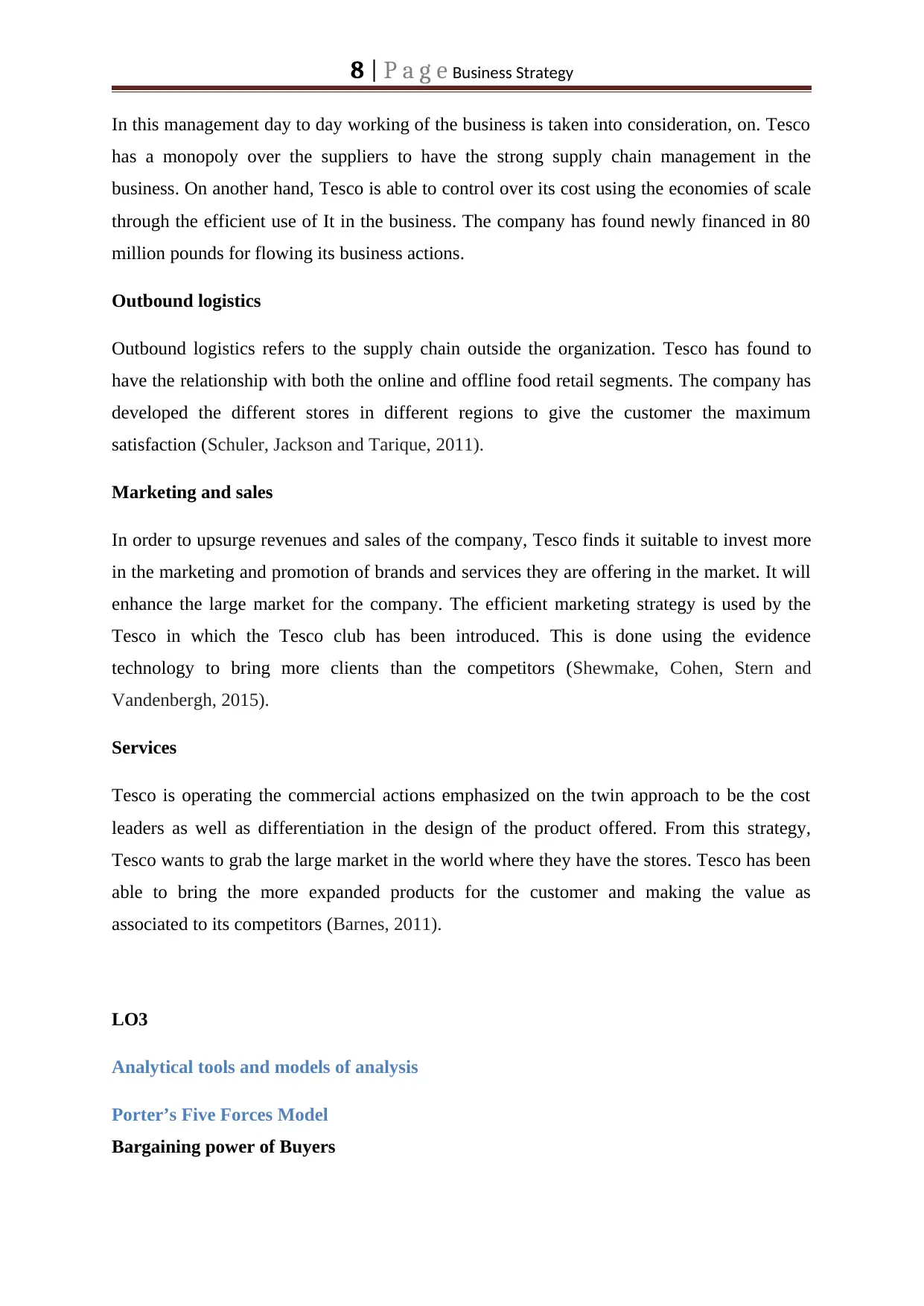
8 | P a g e Business Strategy
In this management day to day working of the business is taken into consideration, on. Tesco
has a monopoly over the suppliers to have the strong supply chain management in the
business. On another hand, Tesco is able to control over its cost using the economies of scale
through the efficient use of It in the business. The company has found newly financed in 80
million pounds for flowing its business actions.
Outbound logistics
Outbound logistics refers to the supply chain outside the organization. Tesco has found to
have the relationship with both the online and offline food retail segments. The company has
developed the different stores in different regions to give the customer the maximum
satisfaction (Schuler, Jackson and Tarique, 2011).
Marketing and sales
In order to upsurge revenues and sales of the company, Tesco finds it suitable to invest more
in the marketing and promotion of brands and services they are offering in the market. It will
enhance the large market for the company. The efficient marketing strategy is used by the
Tesco in which the Tesco club has been introduced. This is done using the evidence
technology to bring more clients than the competitors (Shewmake, Cohen, Stern and
Vandenbergh, 2015).
Services
Tesco is operating the commercial actions emphasized on the twin approach to be the cost
leaders as well as differentiation in the design of the product offered. From this strategy,
Tesco wants to grab the large market in the world where they have the stores. Tesco has been
able to bring the more expanded products for the customer and making the value as
associated to its competitors (Barnes, 2011).
LO3
Analytical tools and models of analysis
Porter’s Five Forces Model
Bargaining power of Buyers
In this management day to day working of the business is taken into consideration, on. Tesco
has a monopoly over the suppliers to have the strong supply chain management in the
business. On another hand, Tesco is able to control over its cost using the economies of scale
through the efficient use of It in the business. The company has found newly financed in 80
million pounds for flowing its business actions.
Outbound logistics
Outbound logistics refers to the supply chain outside the organization. Tesco has found to
have the relationship with both the online and offline food retail segments. The company has
developed the different stores in different regions to give the customer the maximum
satisfaction (Schuler, Jackson and Tarique, 2011).
Marketing and sales
In order to upsurge revenues and sales of the company, Tesco finds it suitable to invest more
in the marketing and promotion of brands and services they are offering in the market. It will
enhance the large market for the company. The efficient marketing strategy is used by the
Tesco in which the Tesco club has been introduced. This is done using the evidence
technology to bring more clients than the competitors (Shewmake, Cohen, Stern and
Vandenbergh, 2015).
Services
Tesco is operating the commercial actions emphasized on the twin approach to be the cost
leaders as well as differentiation in the design of the product offered. From this strategy,
Tesco wants to grab the large market in the world where they have the stores. Tesco has been
able to bring the more expanded products for the customer and making the value as
associated to its competitors (Barnes, 2011).
LO3
Analytical tools and models of analysis
Porter’s Five Forces Model
Bargaining power of Buyers
⊘ This is a preview!⊘
Do you want full access?
Subscribe today to unlock all pages.

Trusted by 1+ million students worldwide
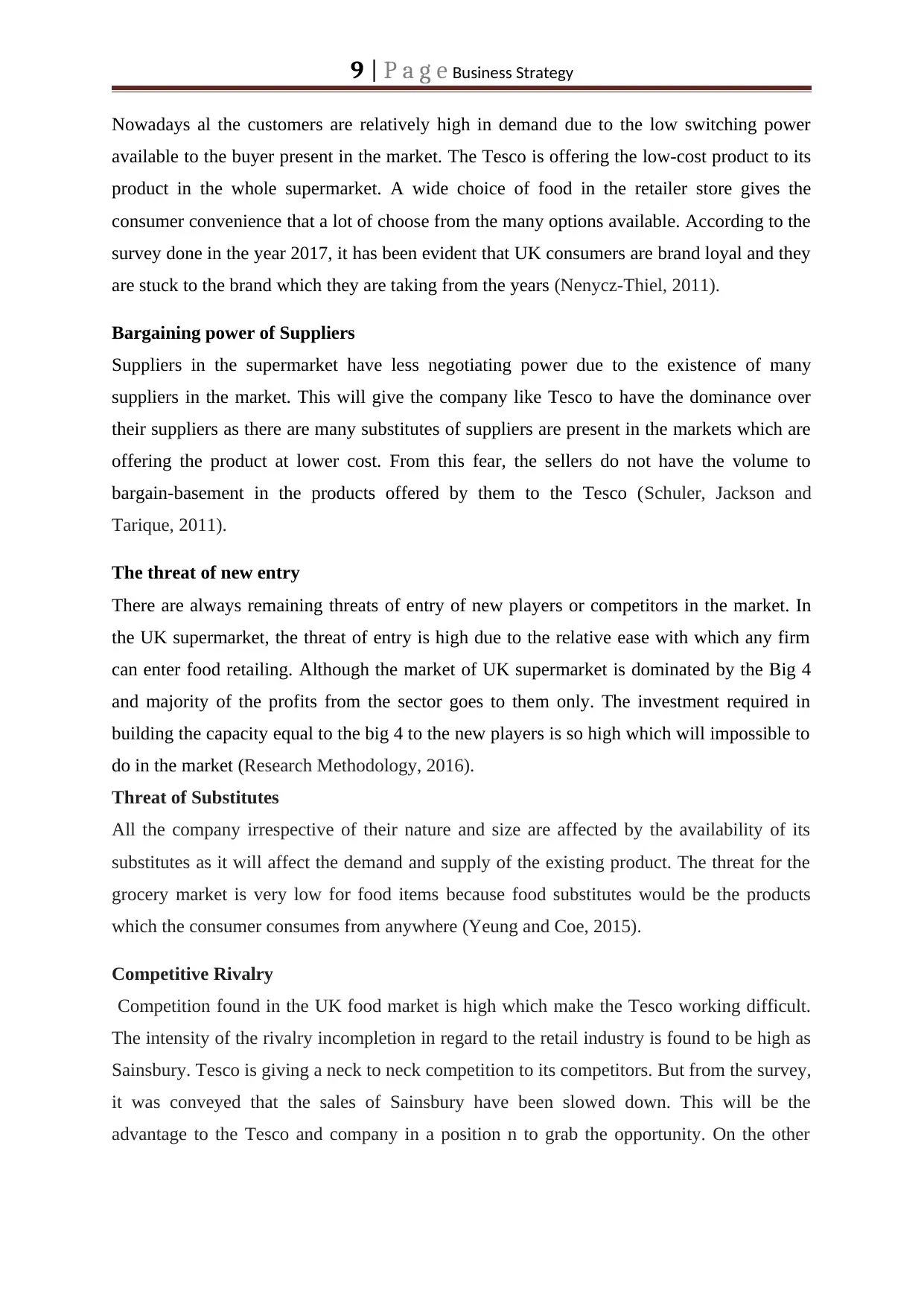
9 | P a g e Business Strategy
Nowadays al the customers are relatively high in demand due to the low switching power
available to the buyer present in the market. The Tesco is offering the low-cost product to its
product in the whole supermarket. A wide choice of food in the retailer store gives the
consumer convenience that a lot of choose from the many options available. According to the
survey done in the year 2017, it has been evident that UK consumers are brand loyal and they
are stuck to the brand which they are taking from the years (Nenycz-Thiel, 2011).
Bargaining power of Suppliers
Suppliers in the supermarket have less negotiating power due to the existence of many
suppliers in the market. This will give the company like Tesco to have the dominance over
their suppliers as there are many substitutes of suppliers are present in the markets which are
offering the product at lower cost. From this fear, the sellers do not have the volume to
bargain-basement in the products offered by them to the Tesco (Schuler, Jackson and
Tarique, 2011).
The threat of new entry
There are always remaining threats of entry of new players or competitors in the market. In
the UK supermarket, the threat of entry is high due to the relative ease with which any firm
can enter food retailing. Although the market of UK supermarket is dominated by the Big 4
and majority of the profits from the sector goes to them only. The investment required in
building the capacity equal to the big 4 to the new players is so high which will impossible to
do in the market (Research Methodology, 2016).
Threat of Substitutes
All the company irrespective of their nature and size are affected by the availability of its
substitutes as it will affect the demand and supply of the existing product. The threat for the
grocery market is very low for food items because food substitutes would be the products
which the consumer consumes from anywhere (Yeung and Coe, 2015).
Competitive Rivalry
Competition found in the UK food market is high which make the Tesco working difficult.
The intensity of the rivalry incompletion in regard to the retail industry is found to be high as
Sainsbury. Tesco is giving a neck to neck competition to its competitors. But from the survey,
it was conveyed that the sales of Sainsbury have been slowed down. This will be the
advantage to the Tesco and company in a position n to grab the opportunity. On the other
Nowadays al the customers are relatively high in demand due to the low switching power
available to the buyer present in the market. The Tesco is offering the low-cost product to its
product in the whole supermarket. A wide choice of food in the retailer store gives the
consumer convenience that a lot of choose from the many options available. According to the
survey done in the year 2017, it has been evident that UK consumers are brand loyal and they
are stuck to the brand which they are taking from the years (Nenycz-Thiel, 2011).
Bargaining power of Suppliers
Suppliers in the supermarket have less negotiating power due to the existence of many
suppliers in the market. This will give the company like Tesco to have the dominance over
their suppliers as there are many substitutes of suppliers are present in the markets which are
offering the product at lower cost. From this fear, the sellers do not have the volume to
bargain-basement in the products offered by them to the Tesco (Schuler, Jackson and
Tarique, 2011).
The threat of new entry
There are always remaining threats of entry of new players or competitors in the market. In
the UK supermarket, the threat of entry is high due to the relative ease with which any firm
can enter food retailing. Although the market of UK supermarket is dominated by the Big 4
and majority of the profits from the sector goes to them only. The investment required in
building the capacity equal to the big 4 to the new players is so high which will impossible to
do in the market (Research Methodology, 2016).
Threat of Substitutes
All the company irrespective of their nature and size are affected by the availability of its
substitutes as it will affect the demand and supply of the existing product. The threat for the
grocery market is very low for food items because food substitutes would be the products
which the consumer consumes from anywhere (Yeung and Coe, 2015).
Competitive Rivalry
Competition found in the UK food market is high which make the Tesco working difficult.
The intensity of the rivalry incompletion in regard to the retail industry is found to be high as
Sainsbury. Tesco is giving a neck to neck competition to its competitors. But from the survey,
it was conveyed that the sales of Sainsbury have been slowed down. This will be the
advantage to the Tesco and company in a position n to grab the opportunity. On the other
Paraphrase This Document
Need a fresh take? Get an instant paraphrase of this document with our AI Paraphraser
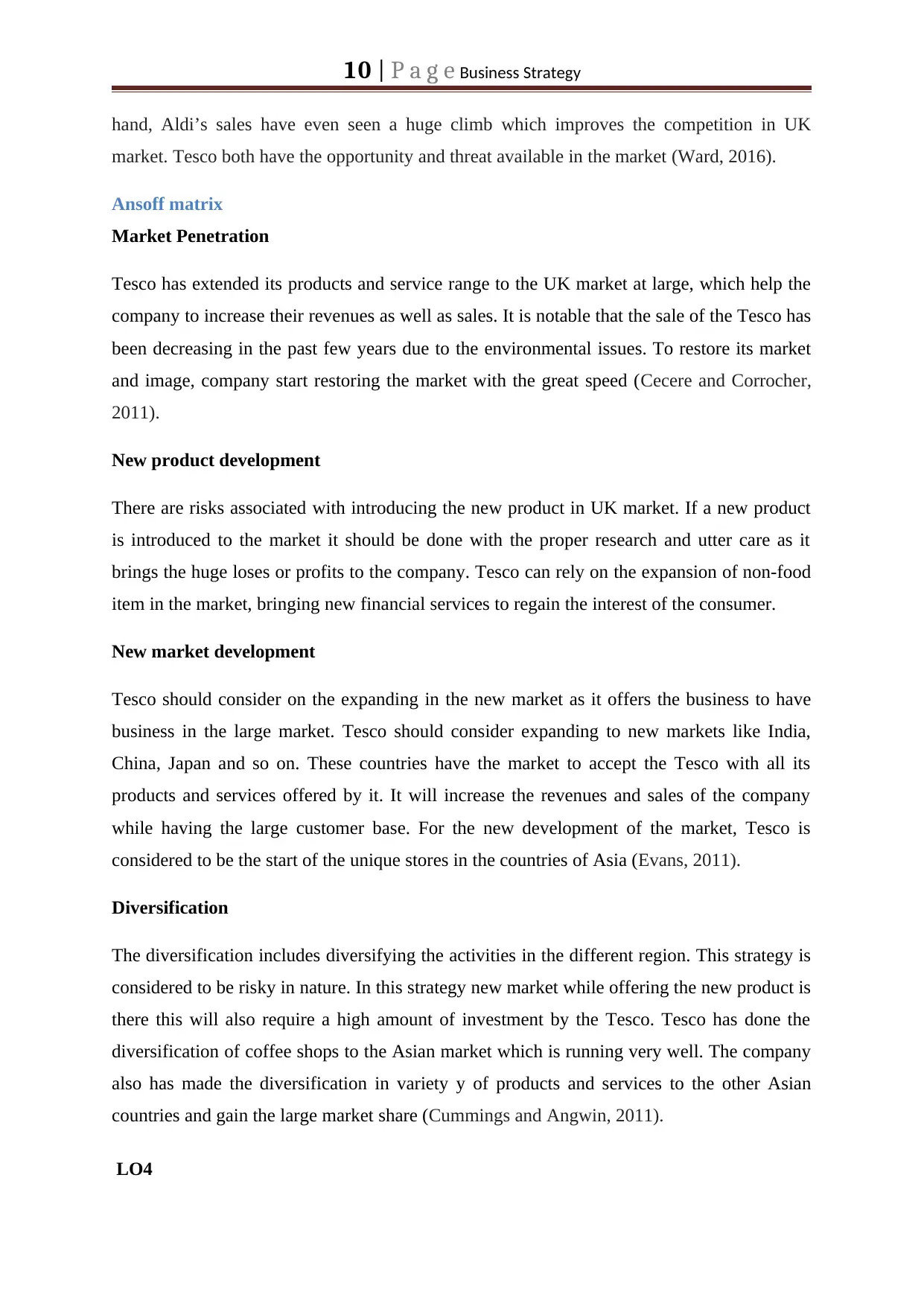
10 | P a g e Business Strategy
hand, Aldi’s sales have even seen a huge climb which improves the competition in UK
market. Tesco both have the opportunity and threat available in the market (Ward, 2016).
Ansoff matrix
Market Penetration
Tesco has extended its products and service range to the UK market at large, which help the
company to increase their revenues as well as sales. It is notable that the sale of the Tesco has
been decreasing in the past few years due to the environmental issues. To restore its market
and image, company start restoring the market with the great speed (Cecere and Corrocher,
2011).
New product development
There are risks associated with introducing the new product in UK market. If a new product
is introduced to the market it should be done with the proper research and utter care as it
brings the huge loses or profits to the company. Tesco can rely on the expansion of non-food
item in the market, bringing new financial services to regain the interest of the consumer.
New market development
Tesco should consider on the expanding in the new market as it offers the business to have
business in the large market. Tesco should consider expanding to new markets like India,
China, Japan and so on. These countries have the market to accept the Tesco with all its
products and services offered by it. It will increase the revenues and sales of the company
while having the large customer base. For the new development of the market, Tesco is
considered to be the start of the unique stores in the countries of Asia (Evans, 2011).
Diversification
The diversification includes diversifying the activities in the different region. This strategy is
considered to be risky in nature. In this strategy new market while offering the new product is
there this will also require a high amount of investment by the Tesco. Tesco has done the
diversification of coffee shops to the Asian market which is running very well. The company
also has made the diversification in variety y of products and services to the other Asian
countries and gain the large market share (Cummings and Angwin, 2011).
LO4
hand, Aldi’s sales have even seen a huge climb which improves the competition in UK
market. Tesco both have the opportunity and threat available in the market (Ward, 2016).
Ansoff matrix
Market Penetration
Tesco has extended its products and service range to the UK market at large, which help the
company to increase their revenues as well as sales. It is notable that the sale of the Tesco has
been decreasing in the past few years due to the environmental issues. To restore its market
and image, company start restoring the market with the great speed (Cecere and Corrocher,
2011).
New product development
There are risks associated with introducing the new product in UK market. If a new product
is introduced to the market it should be done with the proper research and utter care as it
brings the huge loses or profits to the company. Tesco can rely on the expansion of non-food
item in the market, bringing new financial services to regain the interest of the consumer.
New market development
Tesco should consider on the expanding in the new market as it offers the business to have
business in the large market. Tesco should consider expanding to new markets like India,
China, Japan and so on. These countries have the market to accept the Tesco with all its
products and services offered by it. It will increase the revenues and sales of the company
while having the large customer base. For the new development of the market, Tesco is
considered to be the start of the unique stores in the countries of Asia (Evans, 2011).
Diversification
The diversification includes diversifying the activities in the different region. This strategy is
considered to be risky in nature. In this strategy new market while offering the new product is
there this will also require a high amount of investment by the Tesco. Tesco has done the
diversification of coffee shops to the Asian market which is running very well. The company
also has made the diversification in variety y of products and services to the other Asian
countries and gain the large market share (Cummings and Angwin, 2011).
LO4
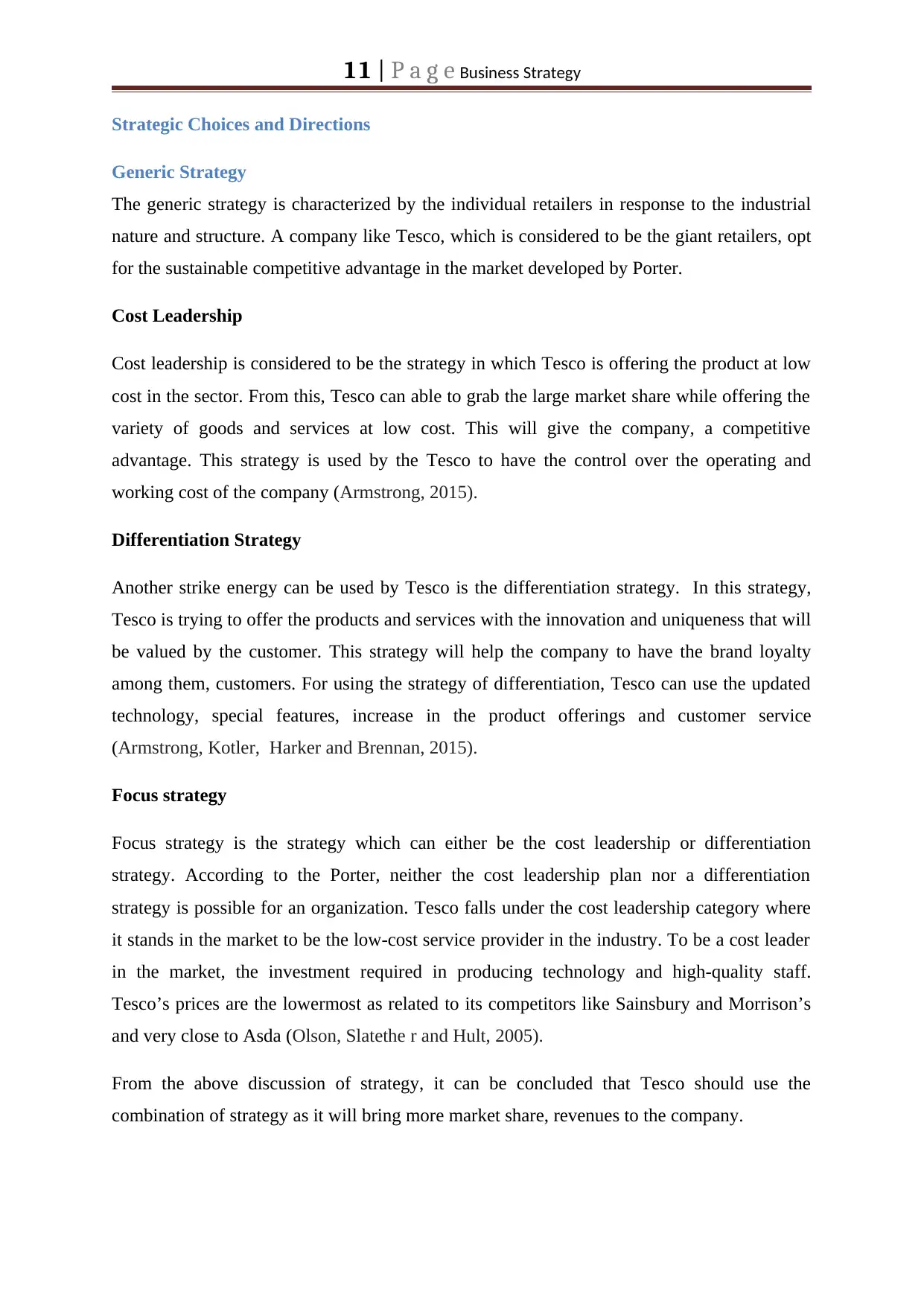
11 | P a g e Business Strategy
Strategic Choices and Directions
Generic Strategy
The generic strategy is characterized by the individual retailers in response to the industrial
nature and structure. A company like Tesco, which is considered to be the giant retailers, opt
for the sustainable competitive advantage in the market developed by Porter.
Cost Leadership
Cost leadership is considered to be the strategy in which Tesco is offering the product at low
cost in the sector. From this, Tesco can able to grab the large market share while offering the
variety of goods and services at low cost. This will give the company, a competitive
advantage. This strategy is used by the Tesco to have the control over the operating and
working cost of the company (Armstrong, 2015).
Differentiation Strategy
Another strike energy can be used by Tesco is the differentiation strategy. In this strategy,
Tesco is trying to offer the products and services with the innovation and uniqueness that will
be valued by the customer. This strategy will help the company to have the brand loyalty
among them, customers. For using the strategy of differentiation, Tesco can use the updated
technology, special features, increase in the product offerings and customer service
(Armstrong, Kotler, Harker and Brennan, 2015).
Focus strategy
Focus strategy is the strategy which can either be the cost leadership or differentiation
strategy. According to the Porter, neither the cost leadership plan nor a differentiation
strategy is possible for an organization. Tesco falls under the cost leadership category where
it stands in the market to be the low-cost service provider in the industry. To be a cost leader
in the market, the investment required in producing technology and high-quality staff.
Tesco’s prices are the lowermost as related to its competitors like Sainsbury and Morrison’s
and very close to Asda (Olson, Slatethe r and Hult, 2005).
From the above discussion of strategy, it can be concluded that Tesco should use the
combination of strategy as it will bring more market share, revenues to the company.
Strategic Choices and Directions
Generic Strategy
The generic strategy is characterized by the individual retailers in response to the industrial
nature and structure. A company like Tesco, which is considered to be the giant retailers, opt
for the sustainable competitive advantage in the market developed by Porter.
Cost Leadership
Cost leadership is considered to be the strategy in which Tesco is offering the product at low
cost in the sector. From this, Tesco can able to grab the large market share while offering the
variety of goods and services at low cost. This will give the company, a competitive
advantage. This strategy is used by the Tesco to have the control over the operating and
working cost of the company (Armstrong, 2015).
Differentiation Strategy
Another strike energy can be used by Tesco is the differentiation strategy. In this strategy,
Tesco is trying to offer the products and services with the innovation and uniqueness that will
be valued by the customer. This strategy will help the company to have the brand loyalty
among them, customers. For using the strategy of differentiation, Tesco can use the updated
technology, special features, increase in the product offerings and customer service
(Armstrong, Kotler, Harker and Brennan, 2015).
Focus strategy
Focus strategy is the strategy which can either be the cost leadership or differentiation
strategy. According to the Porter, neither the cost leadership plan nor a differentiation
strategy is possible for an organization. Tesco falls under the cost leadership category where
it stands in the market to be the low-cost service provider in the industry. To be a cost leader
in the market, the investment required in producing technology and high-quality staff.
Tesco’s prices are the lowermost as related to its competitors like Sainsbury and Morrison’s
and very close to Asda (Olson, Slatethe r and Hult, 2005).
From the above discussion of strategy, it can be concluded that Tesco should use the
combination of strategy as it will bring more market share, revenues to the company.
⊘ This is a preview!⊘
Do you want full access?
Subscribe today to unlock all pages.

Trusted by 1+ million students worldwide
1 out of 17
Related Documents
Your All-in-One AI-Powered Toolkit for Academic Success.
+13062052269
info@desklib.com
Available 24*7 on WhatsApp / Email
![[object Object]](/_next/static/media/star-bottom.7253800d.svg)
Unlock your academic potential
Copyright © 2020–2025 A2Z Services. All Rights Reserved. Developed and managed by ZUCOL.





